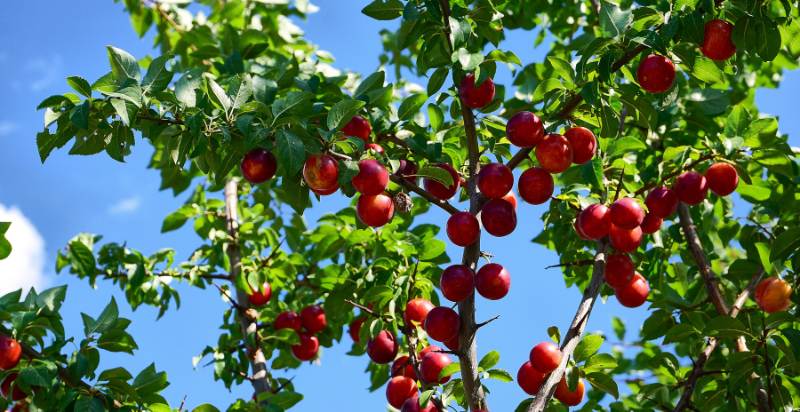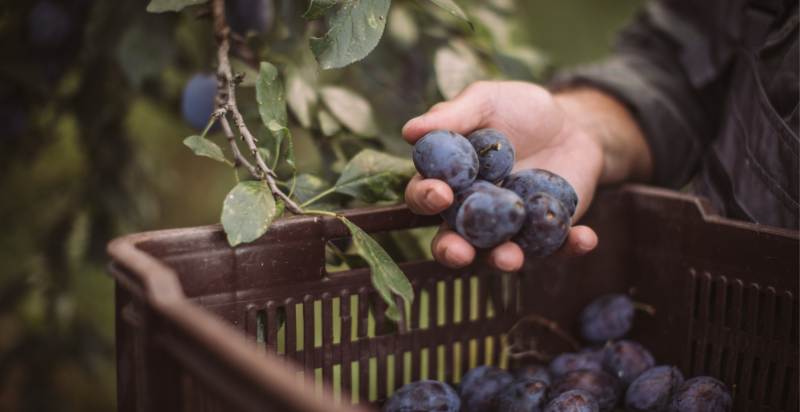Plum trees are delicious fruit trees that can be grown in your garden. They are hardy and easy to care for and produce plenty of plums.
In this post, we will discuss how to grow a plum tree and care for it so you can enjoy delicious plums for years to come. Let’s get started!
What is Plum?
The plum is a fruit tree of the genus Prunus and can be classified into two distinct types: European plums (Prunus domestica) and Japanese plums (Prunus salicina). The former is grown extensively in Europe, North America, and Australia, while the latter is cultivated mainly in China, Japan, and Korea. Prunus trees are deciduous, which means they lose their leaves in the winter.
Plum trees typically grow to a height of 15-20 feet (4.5-6 meters), although some varieties can reach up to 30-40 feet (9-12 meters). The branches of plum trees are covered with small, round leaves arranged alternately along the stem. The flowers of plum trees have five petals and are white or pink. The fruit of plum trees is a drupe, meaning that it has a hard pit surrounded by fleshy pulp. Plums come in various colors, including yellow, red, purple, and blue.
Plums are a good source of vitamins A and C, fiber, and antioxidants. They can be eaten fresh, canned, or dried. Plum juice is also popular and is often used to make wine and jam.
Types of Plums:
As mentioned earlier, there are two main plums: European and Japanese. European plums are further divided into two subcategories: prunes and gages. Prunes are plums that have been dried and have a wrinkled appearance. Gages, on the other hand, are fresh plums that have been cooked in syrup.
Japanese plums, also known as “Chinese” or “Asian” plums, are distinguished from European plums by their oval shape and smooth skin. Unlike European plums, Japanese plums can be eaten raw without being cooked first. Hybrid plums are also available in the market.
History of Plums:
Chinese people have been cultivating the plum tree for more than 4,000 years. It originated in China and later moved to Japan, Korea, Europe, and North America. Early European settlers brought plum trees to North America in the 1600s.
The Bible is one of several ancient books to reference the plum tree. According to the account of Genesis, a “forbidden fruit”—likely a plum—tried to seduce Adam and Eve. Plums are also mentioned in Chinese poetry and literature and were a popular motif in Japanese art.
Uses for Plums:
Plums can be eaten fresh, canned, or dried. They can also be used to make juice, jam, and wine. Plum leaves can be used as herbal tea.
Plums are an excellent source of antioxidants, fiber, and vitamins A and C. They may aid in preventing cancer and other diseases, as well as help to strengthen the immune system.
Cultivation of Plums:
Plum trees can be grown in various climates but prefer warm weather. They need full sun and well-drained soil. They can take up to five years to bear fruit and are typically cultivated by grafting.
To maintain healthy plum trees, pruning is necessary. Before new growth starts, prune plum trees in late winter or early spring.
Health Benefits of Plums:
Plums have a variety of different health advantages. Plums are a good source of fiber, antioxidants, and vitamins A and C. They may help prevent cancer and other diseases by boosting the immune system.
Plums also contain a compound called “anthocyanins,” believed to have anti-inflammatory properties. Anthocyanins are also found in other fruits and vegetables, such as blueberries, strawberries, and raspberries.
In addition to their nutritional value, plums have several other benefits for the human body. For example, plums can help improve digestion, promote weight loss, and lower blood pressure. Plums are also thought to have anti-aging properties and help keep skin looking young and healthy.

How To Grow And Care For Plum Plant?
Plum trees are relatively easy to grow but require specific conditions to thrive. Plum trees need full sun and well-drained soil to produce healthy fruit. They should be pruned annually to promote new growth and prevent disease.
When planting your plum tree, be sure to choose a variety that is suited to your climate. Some varieties of plum trees are more cold-hardy than others, so selecting a tree that can withstand the winters in your area is important.
Once your plum tree is established, it’s important to water it regularly and fertilize it according to the manufacturer’s instructions. You must also watch for any signs of disease or pest activity on your tree and act quickly if anything goes wrong.
Your plum tree will give you years of delicious fruit with proper care. Follow the tips in this guide, and enjoy the bounty of your backyard orchard!
Selecting a Plum Tree:
Many different types of plum trees are available, so it’s crucial to pick one that thrives in your region. Choose a variety of plum trees known to be winter-hardy if you reside in a region with harsh winters. Some popular varieties of cold-hardy plum trees include ‘Stanley,’ ‘Pembina,’ and ‘Superior.’
If you live in a warmer climate, wide varieties of plum trees will do well in your area. Some popular warm-weather varieties include ‘Burbank,’ ‘Santa Rosa,’ and ‘Wickson.’
No matter what climate you live in, select a disease-resistant plum tree. Some varieties of plum trees are more susceptible to diseases like brown rot and powdery mildew, so it’s important to choose a healthy tree to begin with.
These are available for purchase at most nurseries and garden centers. You can also order trees online from specialty growers. Be sure to select a reputable supplier to ensure that you receive a high-quality tree.
When planting your plum tree, pick a spot with plenty of sunlight and well-drained soil. Choose a location in your yard where the plum trees will receive plenty of sunlight throughout the day because they won’t bear fruit otherwise.
Additionally, for plum trees to grow, the soil must be well-drained. Before planting your tree, improve the soil if it is heavy or clay-like. Your soil’s drainage will be aided by adding organic material, such as compost or peat moss.
Planting Your Plum Tree:
Once you’ve selected a location and prepared the soil, you’re ready to plant your plum tree. When you’re ready to plant, be sure to dig a hole twice as wide as the root ball of your tree. This will give your tree’s roots plenty of room to spread and grow.
After digging the hole, place your tree in the hole and backfill it with soil. Be sure to pack the soil firmly around the roots of your tree. After the tree has been planted, give it plenty of water and cover the base of the trunk with mulch.
Caring for Your Plum Tree:
Here are some tips to care for your plum tree:
Watering
Ensure to provide your tree with 1-2 inches of water every week via irrigation or rainfall. You might need to water your plum tree more frequently if you live in a dry climate. If you live in an area with low rainfall, you may need to water your plum tree more frequently.
Fertilizing
To promote healthy growth, plum trees need to be fertilized regularly. Apply a general-purpose fertilizer according to the manufacturer’s instructions, typically two or three times per year.
Pruning
Plum trees must be regularly pruned to produce the best fruit. Remove any diseased or dead branches first. Then, remove any suckers growing from the base of the trunk. Finally, thin out the remaining branches so air can circulate freely through the tree.
Pest and Disease Control
Unfortunately, plum trees are susceptible to a variety of pests and diseases. Be sure to monitor your tree for signs of problems and take action immediately if any problems arise. Some common pests and diseases that affect plum trees include brown rot, powdery mildew, aphids, and caterpillars.
Harvesting Your Plums:
You’ll be able to reap the rewards of your labor once your plum tree begins to bear fruit! Late summer or early fall is usually when plums are ready for harvest. Squeeze the plums lightly to see if they are ready to be picked. It is ready to be selected if it gives in to pressure.
To harvest your plums:
- Cut the stem with a sharp knife and twist the fruit gently to separate it from the branch.
- Handle the fruit carefully, as bruising can cause the plums to rot.
- Once you’ve harvested all of the ripe fruit, store the plums in a cool, dark place until you’re ready to use them.

How To Store Grown Plums?
The plums should be kept in a cold, dark place. When all the ripe fruit has been collected, store the plums in a cool, dark location until you’re ready to use them. The plums will stay fresh and won’t bruise due to this.
If you have too many plums to eat right away, you can also preserve them by canning or freezing them. Canning is a great way to enjoy your plums year-round, while freezing is a good option if you want to enjoy them later.
No matter how you enjoy your homegrown plums, you’ll be glad you took the time to plant and care for your plum tree!
How to Eat Plum?
There are many ways to enjoy fresh plums. You can eat them right off the tree or use them in recipes like pies, jams, and sauces. You can also preserve your plums by canning or freezing them.
If you need help eating a plum, start washing the fruit under cool, running water. Then, cut away any bruised or damaged areas. To eat a plum, bite into it and enjoy the sweet, juicy flesh. If you find the skin too tart or bitter for your taste, you can always peel it off before eating.
No matter how you enjoy your homegrown plums, you’ll be glad you took the time to plant and care for your plum tree!

Conclusion
Now that you know how to plant and care for a plum tree, you can enjoy fresh, delicious plums from your backyard! With a little effort, you can enjoy a bountiful harvest of plums all season long. So what are you waiting for? Get started today and enjoy the fruits of your labor for years to come!
- Everything You Wanted to Know About Red Tamarillos - June 2, 2025
- A Guide to Tulips: Everything You Need to Know & More… - June 2, 2025
- Guanabana: Description, Flavor, Benefits, And Uses - May 27, 2025

7 thoughts on “Plum Trees: How to Grow and Care for Your Plum Plant”
Comments are closed.